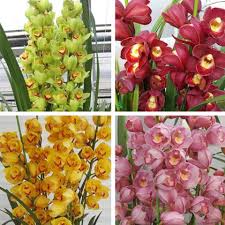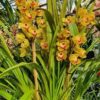# The Impact of Organic Fertilizers on Sato Cymbidium Orchids

Sato Cymbidium orchids, known for their elegant blooms and vibrant colors, have become a favorite among orchid enthusiasts and gardeners alike. To cultivate healthy and flourishing Sato Cymbidium orchids, understanding the impact of fertilizers is crucial. Among the various types of fertilizers available, organic fertilizers have gained popularity due to their numerous benefits, not only for the orchids but also for the environment. This article will delve into the effects of organic fertilizers on Sato Cymbidium orchids, exploring their advantages, recommended types, application methods, and the overall impact on plant growth and health.
## 1. Understanding Organic Fertilizers
Organic fertilizers are derived from natural sources and are rich in essential nutrients required for plant growth. Unlike synthetic fertilizers, which are chemically formulated, organic fertilizers are composed of materials such as plant residues, animal manure, and compost. They provide a slow-release source of nutrients, promoting healthier root systems and improving soil structure.
### a. Nutrient Composition
Organic fertilizers contain a variety of macronutrients and micronutrients, including nitrogen (N), phosphorus (P), potassium (K), calcium, magnesium, sulfur, and trace elements like iron, manganese, and zinc. These nutrients play vital roles in the overall growth and development of Sato Cymbidium orchids.
– **Nitrogen (N)**: Crucial for vegetative growth, nitrogen helps in the development of lush foliage and strong stems.
– **Phosphorus (P)**: Important for root development, phosphorus encourages strong root systems and promotes flowering.
– **Potassium (K)**: Enhances overall plant health, potassium contributes to disease resistance and improves flower quality.
– **Calcium, Magnesium, and Micronutrients**: These nutrients support various physiological processes, contributing to the overall health and vitality of the orchids.
### b. Soil Health Improvement
In addition to providing essential nutrients, organic fertilizers also improve soil structure and enhance microbial activity. The organic matter in these fertilizers increases soil fertility, promotes better drainage, and enhances moisture retention, creating an ideal environment for Sato Cymbidium orchids to thrive.
## 2. Benefits of Organic Fertilizers for Sato Cymbidium Orchids
The use of organic fertilizers offers numerous benefits for the growth and health of Sato Cymbidium orchids. Understanding these advantages can help gardeners make informed decisions about their fertilization practices.
### a. Improved Soil Structure
Organic fertilizers contribute to the improvement of soil structure by enhancing its ability to retain moisture and nutrients. This is particularly important for Sato Cymbidium orchids, which thrive in well-draining but moisture-retentive growing media. Improved soil structure also promotes better root aeration, allowing roots to access oxygen more easily.
### b. Enhanced Nutrient Availability
Organic fertilizers release nutrients slowly over time, ensuring a steady supply of essential elements to the orchids. This slow-release mechanism reduces the risk of nutrient leaching, providing long-lasting benefits compared to synthetic fertilizers, which may lead to rapid nutrient spikes followed by depletion.
### c. Increased Microbial Activity
Organic fertilizers stimulate beneficial microbial activity in the soil. These microorganisms play a crucial role in breaking down organic matter, making nutrients more available to plants. They also contribute to disease suppression, promoting a healthier growing environment for Sato Cymbidium orchids.
### d. Reduced Environmental Impact
By using organic fertilizers, gardeners can minimize their environmental footprint. Organic practices help reduce chemical runoff, prevent soil degradation, and promote biodiversity in the ecosystem. This sustainable approach aligns with the increasing awareness of environmental conservation among gardeners.
### e. Healthier Plant Growth
The holistic benefits of organic fertilizers lead to healthier plant growth. Sato Cymbidium orchids nourished with organic fertilizers tend to exhibit vibrant foliage, robust root systems, and abundant flowering. Healthy plants are more resilient to diseases and pests, reducing the need for chemical interventions.
## 3. Types of Organic Fertilizers for Sato Cymbidium Orchids
Several types of organic fertilizers can be used to nourish Sato Cymbidium orchids. Each type offers unique benefits, allowing gardeners to tailor their fertilization practices based on specific needs.
### a. Compost
**Description**: Compost is decomposed organic matter made from plant residues, kitchen scraps, and other biodegradable materials. It is rich in nutrients and improves soil structure.
**Benefits**: Compost enhances soil fertility, promotes microbial activity, and provides a slow-release source of nutrients. It can be mixed with the growing medium to improve its overall quality.
### b. Well-Rotted Manure
**Description**: Animal manure, when properly aged and decomposed, serves as an excellent organic fertilizer. It is particularly rich in nitrogen and beneficial microorganisms.
**Benefits**: Well-rotted manure improves soil fertility and enhances moisture retention. It also adds organic matter, contributing to better soil structure.
### c. Fish Emulsion
**Description**: Fish emulsion is a liquid organic fertilizer made from fish by-products. It is rich in nitrogen and trace elements.
**Benefits**: Fish emulsion provides a quick boost of nutrients and enhances overall plant vigor. It is ideal for use during the active growing season.
### d. Seaweed Extract
**Description**: Seaweed extract is derived from marine algae and is rich in micronutrients and plant hormones.
**Benefits**: This organic fertilizer promotes root development, enhances stress tolerance, and improves overall plant health. It can be used as a foliar spray or added to the growing medium.
### e. Bone Meal
**Description**: Bone meal is a slow-release organic fertilizer made from ground animal bones. It is high in phosphorus.
**Benefits**: Bone meal encourages strong root development and promotes flowering. It is particularly beneficial during the early stages of growth and when preparing for blooming.
## 4. Application Methods for Organic Fertilizers
Proper application of organic fertilizers is essential to maximize their benefits for Sato Cymbidium orchids. Here are some recommended methods for effective fertilization.
### a. Incorporation into the Growing Medium
When repotting Sato Cymbidium orchids, mix organic fertilizers into the growing medium. This method ensures that the nutrients are readily available to the plant roots. Use a balanced mix of organic materials, such as compost and well-rotted manure, to provide a comprehensive nutrient profile.
### b. Top-Dressing
Top-dressing involves spreading a layer of organic fertilizer on the soil surface without disturbing the existing growing medium. This method allows nutrients to gradually leach into the soil with watering, providing a slow-release effect. Regularly replenishing the top-dressing can sustain nutrient availability throughout the growing season.
### c. Liquid Fertilizer Application
Liquid organic fertilizers, such as fish emulsion and seaweed extract, can be diluted with water and applied during watering. This method allows for rapid nutrient uptake by the orchids, providing an immediate boost during critical growth periods. Follow the manufacturer’s instructions for dilution ratios to avoid over-fertilization.
### d. Foliar Feeding
Foliar feeding involves spraying diluted liquid organic fertilizers directly onto the leaves of the orchids. This method allows for quick absorption of nutrients through the leaf surface, promoting healthy growth. It is particularly effective during the active growing season when the orchids require higher nutrient levels.
## 5. Monitoring the Effects of Organic Fertilizers
To evaluate the impact of organic fertilizers on Sato Cymbidium orchids, it is essential to monitor their growth and overall health regularly. Here are some indicators to consider:
### a. Growth Rate
Observe the growth rate of the orchids after applying organic fertilizers. Healthy Sato Cymbidium orchids should exhibit vigorous growth, with new leaves and roots developing at a consistent pace.
### b. Flowering Performance
Pay attention to the flowering performance of the orchids. Organic fertilizers can enhance bloom quality and quantity. If the orchids produce larger, more vibrant flowers, it may indicate that the fertilization practices are effective.
### c. Leaf Color and Condition
Healthy leaves should display a rich green color, indicating adequate nutrient levels. Yellowing or pale leaves may signal nutrient deficiencies or imbalances. Regularly assess the condition of the leaves to ensure the orchids are receiving proper nutrition.
### d. Root Health
Examine the roots during repotting or if you notice any signs of distress in the orchids. Healthy roots should be firm, white or light tan, and free of rot. A strong root system is essential for nutrient uptake and overall plant health.
## 6. Conclusion
The impact of organic fertilizers on Sato Cymbidium orchids cannot be overstated. By improving soil health, enhancing nutrient availability, and promoting overall plant vigor, organic fertilizers play a crucial role in successful orchid cultivation. The use of organic fertilizers not only benefits the orchids but also aligns with sustainable gardening practices that prioritize environmental conservation.
Understanding the types of organic fertilizers, their application methods, and the benefits they provide empowers orchid enthusiasts to nurture their Sato Cymbidium orchids effectively. As these stunning orchids flourish under the care of organic fertilization, gardeners can enjoy the beauty and elegance of their blooms while contributing to a healthier ecosystem. With the right knowledge and practices, the journey of growing Sato Cymbidium orchids can be both rewarding and sustainable, offering a beautiful addition to any garden or home.
# The Impact of Organic Fertilizers on Sato Cymbidium Orchids (Part 2)
As discussed in the previous part of this article, organic fertilizers provide essential nutrients and enhance soil structure, playing a significant role in the successful cultivation of Sato Cymbidium orchids. In this section, we will delve deeper into the various aspects of organic fertilizers’ impact on the growth, health, and overall well-being of Sato Cymbidium orchids. We will explore the role of organic fertilizers in disease resistance, pest management, environmental sustainability, and practical tips for optimizing their use in your orchid care routine.
## 1. Disease Resistance
One of the most significant benefits of using organic fertilizers in Sato Cymbidium orchid cultivation is the enhanced resistance to diseases. Healthy plants are less susceptible to diseases, and the application of organic fertilizers contributes to this health in several ways.
### a. Strengthened Plant Structure
Organic fertilizers improve the overall vigor of Sato Cymbidium orchids, leading to stronger stems and leaves. A robust plant structure is more capable of withstanding environmental stressors, reducing the risk of diseases that thrive in weakened conditions.
### b. Enhanced Nutrient Uptake
When organic fertilizers are used, the nutrients become more bioavailable to the orchids. This improved nutrient uptake contributes to the production of secondary metabolites, compounds that can bolster a plant’s immune system. Sato Cymbidium orchids that receive adequate nutrition through organic fertilizers are better equipped to fend off pathogens and other stressors.
### c. Promotion of Beneficial Microorganisms
Organic fertilizers foster the growth of beneficial microorganisms in the soil. These microorganisms play a critical role in plant health by outcompeting harmful pathogens, breaking down organic matter, and converting nutrients into forms that are easily absorbed by plants. The presence of beneficial microbes helps establish a balanced ecosystem in the soil, further enhancing the resilience of Sato Cymbidium orchids against diseases.
### d. Prevention of Soil-Borne Diseases
The use of organic fertilizers can also help mitigate the risk of soil-borne diseases, such as root rot and fungal infections. Well-amended soil with organic matter maintains better aeration and drainage, preventing waterlogged conditions that are conducive to disease development. By creating a healthy root environment, organic fertilizers contribute to the overall health of Sato Cymbidium orchids.
## 2. Pest Management
Pest infestations can pose a significant threat to the health of Sato Cymbidium orchids. However, the use of organic fertilizers can play a role in managing pest populations and promoting overall plant health.
### a. Induced Plant Defense Mechanisms
Healthy plants, nourished by organic fertilizers, are better equipped to activate their natural defense mechanisms when faced with pest threats. When orchids receive optimal nutrients, they can produce certain chemical compounds that deter herbivorous insects. This can include increased production of essential oils or other metabolites that make the plant less palatable to pests.
### b. Attraction of Beneficial Insects
Organic fertilizers can help create a balanced ecosystem that attracts beneficial insects, such as ladybugs and predatory wasps, which prey on common orchid pests. The presence of diverse flora, supported by organic fertilization, can provide a habitat for these beneficial insects, thus helping control pest populations naturally.
### c. Reduced Chemical Dependency
By promoting plant health and pest resilience, organic fertilizers can reduce the need for synthetic pesticides. This not only protects the environment from chemical exposure but also minimizes potential harm to the orchids themselves. Sustainable practices like organic fertilization lead to healthier ecosystems and safer growing environments.
## 3. Environmental Sustainability
The use of organic fertilizers aligns with broader principles of environmental sustainability. The cultivation of Sato Cymbidium orchids using organic methods contributes to the preservation of ecosystems and promotes responsible gardening practices.
### a. Reduced Chemical Runoff
Organic fertilizers minimize the risk of chemical runoff into waterways. Synthetic fertilizers can leach into streams and rivers, causing nutrient pollution and harming aquatic ecosystems. In contrast, organic fertilizers are less likely to cause such runoff, preserving water quality and promoting a healthier environment.
### b. Soil Health Improvement
Regular use of organic fertilizers enhances soil health over time. By enriching the soil with organic matter, these fertilizers improve soil structure, promote nutrient cycling, and enhance water retention. Healthy soil contributes to the overall sustainability of the garden ecosystem, supporting diverse plant life and maintaining a balance in nutrient availability.
### c. Promoting Biodiversity
Organic gardening practices, including the use of organic fertilizers, encourage biodiversity in the garden. A diverse plant population attracts a variety of pollinators and beneficial insects, creating a thriving ecosystem that supports both plant and animal life. By cultivating Sato Cymbidium orchids organically, gardeners contribute to the conservation of local flora and fauna.
### d. Carbon Sequestration
The application of organic fertilizers can aid in carbon sequestration, a critical process for combating climate change. Organic matter in the soil captures carbon dioxide from the atmosphere, storing it in a stable form. This process not only contributes to soil health but also mitigates the effects of greenhouse gas emissions.
## 4. Practical Tips for Using Organic Fertilizers on Sato Cymbidium Orchids
To maximize the benefits of organic fertilizers for Sato Cymbidium orchids, here are some practical tips to consider:
### a. Timing of Application
Timing is crucial when applying organic fertilizers. Sato Cymbidium orchids typically experience two growth phases: active growth during the spring and summer, and a dormancy period in the fall and winter. It is essential to provide fertilizers during the active growth phase to ensure the orchids receive the nutrients they need for optimal growth and flowering.
### b. Regular Soil Testing
Conduct regular soil tests to assess nutrient levels and pH. Understanding the existing nutrient profile allows you to tailor your organic fertilization practices to meet the specific needs of your Sato Cymbidium orchids. Soil testing helps prevent nutrient imbalances and guides decisions about fertilizer application rates.
### c. Incorporate Diverse Organic Amendments
To provide a comprehensive nutrient profile, consider incorporating a variety of organic amendments into your fertilization routine. Mixing compost, well-rotted manure, and other organic materials can create a balanced approach to fertilization, ensuring that your Sato Cymbidium orchids receive a diverse range of nutrients.
### d. Monitor Plant Health
Regularly monitor the health and appearance of your Sato Cymbidium orchids. Pay attention to leaf color, growth patterns, and overall vigor. If you notice signs of nutrient deficiencies or imbalances, adjust your fertilization practices accordingly. Healthy plants will respond positively to organic fertilization, showcasing vibrant foliage and abundant blooms.
### e. Follow Application Guidelines
Always follow the manufacturer’s guidelines for the application of organic fertilizers. Over-fertilization can lead to nutrient imbalances, root burn, or other adverse effects. Use appropriate dilution rates for liquid fertilizers and adhere to recommended application frequencies for solid fertilizers.
## 5. Conclusion
The impact of organic fertilizers on Sato Cymbidium orchids extends beyond mere nutrient provision. Organic fertilizers enhance plant health, promote disease resistance, and contribute to sustainable gardening practices. By nurturing these beautiful orchids with organic methods, gardeners can cultivate resilient plants that thrive in their environments.
Understanding the multifaceted benefits of organic fertilizers empowers orchid enthusiasts to make informed choices about their cultivation practices. The journey of growing Sato Cymbidium orchids can be a rewarding experience, blending aesthetic beauty with environmental stewardship. Through careful application and monitoring, gardeners can create a flourishing oasis of Sato Cymbidium orchids that not only captivates the eye but also contributes to a healthier planet.

